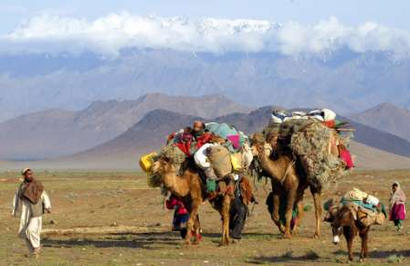War and Modernity:
Hard Times for Afghanistan's Kuchi Nomads
by Marc W. Herold
Departments of Economics and Women's Studies
Whittemore School of Business & Economics
University of New Hampshire
POSTED OCTOBER 1, 2003 --
"Nomadic tribesman Haji Lawang saw the outline of the helicopter in the night sky and heard its roar as it streaked low over his three tents. A moment later, an explosion shook the ground and fire flew up from the desert about a mile away. The 50-year-old huddled with his two wives, four children, goats and camels and prayed his family wouldn't also be attacked. At dawn, he went out to investigate and found his neighbors' camp in ruins. Five women and four children were dead and six people were wounded, he said.
The U.S. military in Afghanistan said one of its helicopters attacked a tent the night of Sept. 18 in Naubahar district and killed two Taliban militants...The military initially said it was "highly confident" that only enemy fighters had been killed. Later, it said it was investigating reports of 'noncombatant casualties.'"
-- Associated Press, September 25, 20031
Haji Khan used to have 300 sheep, two horses and nine camels. He now has only one camel and lives in a 4m x 2m UNHCR tent in the sprawling refugee camp of Spin Boldak. He recalls other times before the rains stopped. Life was good, "we never used to let our daughters marry people from the city because if they settled they would be like a bird in a cage. Now we are like a bird in a cage."2 For centuries, the nomadic Kuchi tribespeople - Kuchi in Persian means "those who move" - migrated across parts of Afghanistan semi-annually with their caravans of goat, sheep, donkeys and camels. In the eyes of the West, Kuchis are famous as silver and lapis lazuli bejeweled and brightly robed, carefree nomads.
Kuchis live in a delicate symbiotic relationship with peasants and environment. Traditionally, they lived by selling young animals, dairy products, wool, sheepskins, meat, or bartering those goods, for wheat grain, vegetables, fruits, and other foodstuffs. Nomads contribute importantly to the national economy in terms of meat, skins and wool. The nomads provided villagers with tea, sugar, matches, kerosene, guns, etc. as well as being moneylenders to village farmers.3 Being able to move from pasture to pasture, nomads escape the limits on size of local herds which villagers are subject to. The Afghan nomads are important for the maintenance of the marginal hilly grasslands.
Kuchis are Pashtuns from southwestern and eastern Afghanistan. In 1892, King Abdul Rahman granted Pashtun Kuchis grazing rights in the Hazarajat and also moved Kuchis and peasants into northern areas populated by Tajiks and Uzbeks, a move which resulted in continued ethnic strain. Many Pashtun Kuchis have fled southward from the ethnic cleansing being carried out in the North by U.S-allied warlords, Generals Rashid Dostum and Mohammad Atta.4
The Kuchi's lifestyle has been eroded both by long-term changes associated with "modernization" and by devastating short-term events [like the droughts of 1971/2 and 1998/2002, and the wars of the 80s, 90s and today]. Their population was estimated at 2 - 2.5 million in the 60s, 70s and early 80s, but has shrunk to 1.3 - 1.5 million today according to a recent study by the UN's World Food Program.5 Roads, drought, landmines, Russian bombing, U.S. cluster bombs, and war-related impoverishment have all played a role in this halving of the Kuchi population.

Kuchi Spring migration [Reuters photo, 2003]
A classic academic analysis of the sedentarization of nomads was provided by the Norwegian anthropologist, Fredrik Barth, who analyzed south Persia.6 He argued the wealthiest and the poorest nomads will tend to settle on land and give-up the nomadic migratory cycle. A pastoral family needs a minimum herd size in order to survive. A wealthy nomad, on the other hand, might experience diminishing returns as his herd size increases and may decide to diversify into investing in land and/or into trade - such diversification also reduces risk.
The poorest lose their herds in times of crisis, going into debt and then selling-off animals to pay off the debt. The wealthy invest their monetary surpluses in land which they then live on, sometimes hiring impoverished kuchis to tend their herds. This pattern is confirmed by Klaus Ferdinand for the Ghilzai nomads of eastern Afghanistan.7 The aim of the modernist central administration in Kabul has been, of course, sedentarization of the nomads, e.g., as pursued in the Helmand Valley Authority scheme of the 50s and 60s. The Helmand project failed due to acute salinization and nomad resistance.
A diversity of actual living situations exists amongst the Afghan nomads in regards to the extent to which tent-dwelling pastoralists engage also in agricultural pursuits.8 Afghan nomads comprise two larger groupings: the western one of the desert southwest largely from the Durrani tribes and the eastern group drawn from various Ghilzai tribes associated with better watered, lusher grazing grounds of the east.9
The northward camel trains of the Kuchis carrying wares north began contracting in the 50s, leading to widespread semi-nomadism. Wealthier Kuchi traders were lured into investing in land and some even took up the settled lives of merchants.10 The rapid development of the road system in the later 50s and 60s - financed by Soviet and U.S. aid - led to severe competition by truckers with the traditional camel caravans. Driven out of business, some Kuchis began operating trucking businesses combined with land ownership. Other Kuchis purchased or hired trucks to assist them in moving between pastures.
The slow demise of the Kuchis was greatly accelerated by the warring after 1979. The spreading of land mines and the Russian bombing campaign slaughtered animals and nomads. Incessant fighting often blocked migratory routes. The terrible drought of 1998 - 2002 is responsible to the death of 75% of the Kuchi animal herds - their major economic capital asset. Drought baked winter grazing areas in the southern plains, forcing hundreds of thousands northward, but the snow-melt failed to replenish rivers and summer pastures also failed.11
Shamir, who lost all 200 of his sheep and goats in the drought, says
"...we used to sing about everything. Women would dance, especially at weddings....but all that has gradually disappeared. Poor people cannot afford drums and music. This war and now this drought have swept everything away."12
Another Kuchi mused,
"We had a good life under the Taliban. There was security and there was peace, and we could go anywhere with our animals...we were not people of any Government. We were only busy grazing our animals."
Many of the once independent, self-sufficient [in conjunction with the tribal peasantry] Kuchis have been reduced to destitute farmers, internally displaced persons, casual laborers, and beggars.13 Haji Mundai, once a leader of a group of eight families, has set up his tent alongside the highway on the scorching plain outside Kandahar. His sheep and goats sold, he works for two dollars a day baking bricks in a kiln.
U.S. cluster bombs and other kinds of unexploded ordnance should be considered 'pollution' as they render soil useless for agriculture and pasture. The burden of landmines and cluster-bombs has been especially heavy for Afghanistan's nomads.14 Over a hundred Kuchi nomads were directly killed by U.S. bombs at Karam, Chowkar Karez, Kandahar, Shawalikot, Helmand, and Maiwand. For example, on December 5, 2001, U.S. bombs mistook a Kuchi camp in Shawalikot for a Taliban position - killing 12 people from two Kuchi families. Kuchi encampments have been raided by U.S. troops, e.g., on January 25, 2002, thirty U.S. soldiers backed up by jets and helicopters descended upon a 100 tent camp in the Bak district 28 kms. north of Khost. And then on September 18, 2003, U.S. Apache attack helicopters fired upon "a tent" in the Naubahar district of Zabul. Tribesman Haji Lawang said five women and four children were killed and six people were wounded. The U.S. military said it was investigating reports of "noncombatant casualties."15
The Pashtun nomads' double-headed drums and lutes drums are silent, the sheep sold. Kuchi nomads have little left to sing about.
-- 30 --
Footnotes
1. Afghan Nomads Say U.S. Bombing Killed Nine, Associated Press, September 25, 2003 http://abcnews.go.com/wire/World/ap20030925_221.html
2. Mike White, "Kuchi Land Gone Dry," The News [February 2003]
3. Described in the classic text, Louis Dupree, Afghanistan [Princeton: Princeton University Press, 1973]: 180
4. "IDPs Continue Arriving in the South," IRIN News [April 15, 2003]
5. Cited in Carlotta Gall, "A Nomadic Way of Life Is At Risk in Afghanistan," New York Times [November 6, 2002] See also Barry Bearak, "In Dysfunctional Afghanistan, a Torturing Drought," New York Times [June 8, 2000], "Drought Reduces Life to a Torture in Afghanistan," Frontier Post [June 13, 2000], at: http://rawa.fancymarketing.net/drought3.htm
6. In Fredrik Barth, Nomads of South Persia [London: George Allen and Unwin, 1961]
7. Klaus Ferdinand, "Ost-Afghanische Nomadismus - ein Beitrag zur Anpassungsfahihkeit der Nomaden," in Willy Kraus [ed], Nomadismus als Entwicklungsproblem [Bielefeld: Bertelsman Universitatsverlag, Reinhard Mohn, 1969]. See also Giancarlo Castelli Gattinara, "L'attivita commerciale dei nomadi dell'Afghanistan," Rassegna Italiana di Sociologia 9,3 [July-September 1968]: 499 -519, and Jean-Pierre Dignard, "Les dernieres tribus. De quelques publicationrecentes sur les nomades d'Afghanistan et d'Iran," L'Homme 34,4 [octobre-december 1994]: 143-49, which reviews 17 texts on the topic, the majority of which based on fieldwork completed in the 70s before the forces of modernization had irreversible effects upon nomadic life.
8. Richard Tapper, "Nomadism in Modern Afghanistan: Asset or Anachronism?" in Louis Dupree and Linette Albert [eds], Afghanistan in the 1970s [New York: Praeger Publishers, 1974]: 126-131
9. Tapper, op. cit: 128-9, who bases much of his chapter on the work of Klaus Ferdinand.
10. From Gorm Pedersen and Ida Nicolaisan, Afghan Nomads in Transition: A Century of Change Among the Zala Khan Khel [London: International Science and Arts Publishers, 1994]
11. Kate Clark, "Afghan Drought Hits Nomads," BBC News [May 1, 2000]
12. "Afghan Nomads Ave Nothing Left to Sing About," Daily Excelsior [August 18, 2002], at : http://www.dailyexcelsior.com/02aug18/inter.htm
13. IRIN, "Afghanistan: Focus on Nomads and the Drought," IRIN News [September 20, 2002]
14. Annasofie Flamand, "Afghanistan's Yellow Flowers," at http://www.le2001.org/tekst/feature_AfghanistanYellowFlowers1.htm and Chris Otton, "Afghan Nomads Ready to Settle Down After Drought Devastation," Agence France-Presse [April 26, 2002].
15. Afghan Nomads Say U.S. Bombing Killed Nine, Associated Press, September 25, 2003 http://abcnews.go.com/wire/World/ap20030925_221.html
